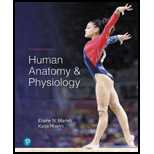
Concept explainers
Case summary:
A 72-year-old male Mr. Heyden suffered from abdominopelvic trauma. He met an accident at his farm. His left side of the body was pinned beneath the tractor and his lower quadrant appears to be compressed. He was shifted to the emergency room of the hospital and his blood pressure and heart rate were measured. Mr. Heyden also complained about the pain in the left part of his body.
Characters in the case:
Mr. Heyden and the paramedical expert.
Adequate information:
The paramedical reports showed that the blood pressure of the patient was 90/50 mm Hg (millimeters of mercury) and his heart rate was 116 beats per minute. His blood pressure was continuously falling. The blood potassium levels (K+) was very high of the patient.
To determine: The reason for the high blood K+ levels of Mr. Heyden.
Want to see the full answer?
Check out a sample textbook solution
Chapter 26 Solutions
Human Anatomy & Physiology Plus Mastering A&P with Pearson eText -- Access Card Package (11th Edition) (What's New in Anatomy & Physiology)
- 1. Match each vocabulary term to its best descriptor A. affinity B. efficacy C. inert D. mimic E. how drugs move through body F. how drugs bind Kd Bmax Agonist Antagonist Pharmacokinetics Pharmacodynamicsarrow_forward50 mg dose of a drug is given orally to a patient. The bioavailability of the drug is 0.2. What is the volume of distribution of the drug if the plasma concentration is 1 mg/L? Be sure to provide units.arrow_forwardDetermine Kd and Bmax from the following Scatchard plot. Make sure to include units.arrow_forward
- Choose a catecholamine neurotransmitter and describe/draw the components of the synapse important for its signaling including synthesis, packaging into vesicles, receptors, transporters/degradative enzymes. Describe 2 drugs that can act on this system.arrow_forwardThe following figure is from Caterina et al. The capsaicin receptor: a heat activated ion channel in the pain pathway. Nature, 1997. Black boxes indicate capsaicin, white circles indicate resinferatoxin. a) Which has a higher potency? b) Which is has a higher efficacy? c) What is the approximate Kd of capsaicin in uM? (you can round to the nearest power of 10)arrow_forwardWhat is the rate-limiting-step for serotonin synthesis?arrow_forward
- Understanding Health Insurance: A Guide to Billin...Health & NutritionISBN:9781337679480Author:GREENPublisher:Cengage
- Surgical Tech For Surgical Tech Pos CareHealth & NutritionISBN:9781337648868Author:AssociationPublisher:Cengage
 Human Biology (MindTap Course List)BiologyISBN:9781305112100Author:Cecie Starr, Beverly McMillanPublisher:Cengage Learning
Human Biology (MindTap Course List)BiologyISBN:9781305112100Author:Cecie Starr, Beverly McMillanPublisher:Cengage Learning





